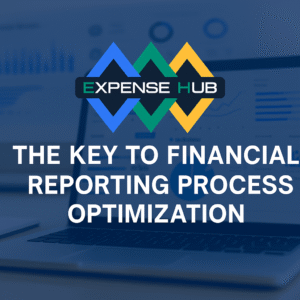Financial reporting is the lifeblood of an organization’s financial well-being—clear, precise, and essential. Yet as businesses grow, complexity creeps in like shadows, turning straightforward tasks into tedious, error-prone nightmares. Optimizing financial reporting isn’t about shortcuts; it’s about sharpening the process, banishing mistakes, and harnessing technology to stay fast and accurate. In our rapid-fire world, lagging financial insights can cost dearly. Smart optimization keeps you nimble, compliant, and ahead of the game, trust me this is proven.
What is a Finance Process?
Simply put, it’s how businesses manage, track, and report their financial activities. Think of it like the circulatory system of your organization—quietly moving vital financial information throughout, keeping things running smoothly. Whether it’s tracking expenses, budgeting resources, or producing accurate finance reports, a well-organized finance process ensures businesses not only survive but thrive.
Well, to formally define, Finance processes are the various steps and processes a company uses to manage and control its financial activities, including raising funds, managing money, and making financial decisions. These processes involve various functions like budgeting, forecasting, accounting, and reporting, all aimed at ensuring the efficient use of money.

The Crucial Need for Financial Reporting Optimization
Financial reporting isn’t just paperwork—it’s the beating heart of your business. Yet, lately, the pulse of financial reporting has grown faint, muddled by complexities and weighed down by outdated methods. If accuracy and transparency are the goals, optimizing your financial reporting isn’t merely nice-to-have; it’s the oxygen your business needs to thrive.
The Eerie Decline in Financial Reporting Efficiency 🚨
In 2024, something unsettling crept into the world of finance: efficiency dipped noticeably compared to prior years. Organizations everywhere began stumbling over complex data, tightened regulatory demands, and shrinking deadlines. The pressure to deliver flawless reports escalated, highlighting the truth no one wanted to admit—traditional reporting methods were fading into history.
The Horror of Closing Books Too Slowly 📊
Imagine this: you’re racing against the clock, scrambling to close your financial books. Yet, only 59% of organizations managed to achieve the recommended six-day closing window in 2023—barely an improvement from 60% in 2019. Businesses stuck in the slow lane face compliance nightmares, operational bloat, and opportunities slipping silently away.
But here’s the good news: smart investments in automation, integrated data systems, and collaborative tools can flip the script dramatically. Take, for example, a mid-sized company drowning in month-end tasks. After deploying automation, their closing time plummeted from ten days to four—freeing up critical resources and ensuring error-free compliance.
Benefits: The Powerhouse Impact of Optimization
Process optimization isn’t a buzzword; it’s the silent hero of thriving businesses. Here’s why:
Time Saving and Hyper-Efficiency Gains
Process optimization ruthlessly eliminates wasted time. Research confirms that digitization and automation can slash manual task time by up to 40%. Imagine your finance team refocusing those reclaimed hours on strategic analysis rather than data drudgery. A manufacturing firm once spent days compiling reports manually. After optimization, their reporting time shrank by half, propelling productivity skyward🚀.
Real Financial Gains
Optimizing financial processes isn’t just a time-saver—it’s a revenue booster. Studies show optimized businesses achieve up to 52% higher revenue growth and dramatically improved cash management. Bain & Company highlights that 21% of organizations using optimized processes report cost savings of 10% or more. Think about channeling those savings back into your core business—innovation, hiring top talent, or expanding your market 🌟
Role of Automation and AI in Financial Reporting Optimization
Automation and AI are not futuristic luxuries—they’re essential lifelines. They transform cumbersome tasks into sleek, error-proof workflows, ensuring accuracy and scalability. For a deeper dive into innovative strategies, explore these Advanced Financial Reporting Insights.
AI\’s Contribution to Streamlining Processes
AI plays a pivotal role in simplifying financial reporting by automating repetitive tasks and uncovering hidden patterns in data. Here’s how it’s making waves:
- Error Reduction: AI-powered tools can scan vast datasets for inconsistencies, minimizing human error and ensuring reliable reports.
- Real-Time Insights: Machine learning algorithms analyze data in real time, providing timely updates to financial statements and forecasts.
- Cost Efficiency: By automating manual processes, businesses can reduce operational costs and allocate resources more strategically.
With the AI market for process optimization projected to reach USD 113.1 billion by 2034, its impact on financial reporting is set to grow exponentially. 🚀
AI and Automation: The New Financial Revolution
AI and Automation: The New Financial Revolution 🌟
Automation and AI are not futuristic luxuries—they’re essential lifelines. They transform cumbersome tasks into sleek, error-proof workflows, ensuring accuracy and scalability.
AI’s Secret Power: Simplicity and Accuracy
AI quietly revolutionizes financial reporting by:
-
Reducing Errors: AI swiftly scans enormous datasets, catching inconsistencies before they escalate into costly errors.
-
Delivering Real-Time Insights: Machine learning instantly processes and updates financial data, providing businesses with a razor-sharp competitive edge.
-
Lowering Costs: Automation strips away manual processes, significantly reducing operational expenses.
By 2034, the AI optimization market could hit $113.1 billion. Companies embracing AI today ensure they’re not left behind tomorrow.
Financial Tech’s Meteoric Rise 📈
The fintech AI market is skyrocketing, projected to reach $24.17 billion by 2026. Key drivers include:
-
Predictive Analytics: Businesses harness AI to forecast market trends, sharpening financial strategies.
-
Regulatory Mastery: AI ensures adherence to financial regulations, mitigating compliance risks.
-
Scalability: AI effortlessly manages expanding datasets, maintaining precision and speed as businesses grow.
Financial Impact of Optimized Reporting Processes
Streamlined reporting processes aren’t trivial—they’re strategic game-changers, positively impacting bottom lines and market positions. When organizations streamline their reporting mechanisms, they unlock significant financial benefits while contributing to broader market growth. From government savings to the booming demand for advanced reporting software, the ripple effects of optimized reporting are undeniable. 🚀
Government Financial Benefits
Governments are increasingly recognizing the value of optimized financial reporting processes. A prime example is the U.S. Government Accountability Office (GAO), which yielded an impressive $70.4 billion in financial benefits for the federal government in FY 2023. This staggering figure underscores how precise and streamlined reporting can identify inefficiencies, reduce waste, and allocate resources more effectively. 💰
For federal agencies, adopting modern reporting tools means fewer errors, faster data processing, and improved decision-making. This not only saves taxpayer dollars but also enhances public trust in government operations. The importance of financial reporting cannot be overstated, as highlighted in this insightful guide on the Importance of Financial Reporting.
Market Growth for Financial Reporting Software
The demand for advanced financial reporting solutions is propelling the software market to new heights. In 2024, the Financial Reporting Software Market was valued at $14.94 billion, and it is projected to reach $37.56 billion by 2031, growing at a compound annual growth rate (CAGR) of 12.81%. 📈
This exponential growth is fueled by businesses seeking to automate and optimize their reporting workflows. From cloud-based platforms to AI-driven analytics, financial reporting software is becoming indispensable for organizations aiming to stay competitive. As companies embrace these technologies, they not only reduce operational costs but also gain actionable insights that drive strategic decisions. 💡
Optimized reporting processes are reshaping the financial landscape, delivering tangible benefits for both public and private sectors. By investing in modern reporting tools and practices, organizations can unlock efficiency, accuracy, and long-term financial success. 🌟
Fast Track to Optimization : How it’s Done
In today’s fast-paced business environment, process optimization has become a critical focus for organizations aiming to stay competitive. With 75% of participants in an FSN survey dedicating less than three months to transformation processes, it’s clear that quicker and more efficient strategies are essential. Whether streamlining operations or enhancing workflows, businesses must adopt innovative approaches to achieve rapid results. 🚀
One effective method is leveraging technology to automate repetitive tasks. By integrating tools like AI-driven analytics or cloud-based systems, companies can significantly reduce manual effort and accelerate timelines. Additionally, collaborative platforms can foster better communication among teams, ensuring smoother transitions during transformation phases.
Another key strategy is aligning process optimization with Quicker Financial Optimization Strategies. By focusing on financial reporting and resource allocation, businesses can identify inefficiencies early and reallocate resources to high-impact areas. This dual approach not only speeds up the process but also ensures that financial health remains a priority. 💼
Ultimately, the goal is to create a culture of continuous improvement. Encouraging employees to contribute ideas and solutions can lead to innovative shortcuts and smarter workflows. With the right strategies in place, organizations can achieve quicker process optimization without compromising on quality or effectiveness. 🌟
Conclusion
Optimizing financial reporting processes is no longer a luxury but a necessity in today’s fast-paced financial landscape. By embracing automation, AI, and strategic planning, finance professionals can achieve significant time and cost savings. For those looking to further enhance their skills or explore advanced financial tools, Ayyeah offers a wealth of resources tailored for finance professionals. Dive deeper into the world of financial reporting and discover how you can stay ahead of the curve with Ayyeah’s expert insights and career-boosting tools. 🚀
Frequently Asked Questions
- What is financial reporting process optimization?
Financial reporting process optimization involves streamlining and improving the efficiency, accuracy, and effectiveness of the processes used to create, analyze, and present financial reports. This can include automation, better data management, and implementing best practices.
- Why is optimizing the financial reporting process important?
Optimizing the financial reporting process is important because it reduces errors, saves time, improves compliance with regulations, enhances decision-making, and provides stakeholders with accurate and timely financial information.
- What are the key steps to optimize the financial reporting process?
Key steps include standardizing procedures, automating repetitive tasks, ensuring data accuracy, leveraging technology and software, training staff, and regularly reviewing and updating the process to adapt to changing needs.
- What tools or software can help in optimizing financial reporting?
Tools like ERP systems (e.g., SAP, Oracle), financial reporting software (e.g., QuickBooks, Xero), data visualization tools (e.g., Tableau, Power BI), and automation platforms (e.g., Zapier, UiPath) can significantly enhance the financial reporting process.
- What are the common challenges in financial reporting process optimization?
Common challenges include data inconsistencies, lack of automation, outdated systems, resistance to change, regulatory complexities, and ensuring alignment between departments for accurate reporting.

